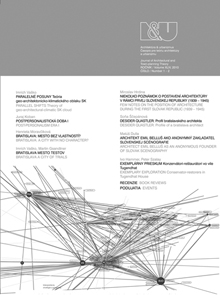Bratislava: mesto bez vlastností?
Bratislava: a city with no character?
Author(s): Henrieta MoravčíkováSubject(s): Cultural Essay, Political Essay, Societal Essay
Published by: Historický ústav SAV, v. v. i.
Keywords: Bratislava; city; post-communist; transformation; identity; image; urban structure; construction development
Summary/Abstract: In the first half of the 1990s, Bratislava has been obscured by booming capitals of neighbouring post-communist countries. The situation though has started to change rapidly after the parliamentary elections of 1998. Launching a number of social and economic reforms, it culminated in the accession of Slovakia to the European Union in 2004 and subsequently to the Shengen Area in 2007. Expected general improvements in economic and social condition of the country, and above all the entry of foreign investment as well as the economic recovery very soon yielded payoffs in Bratislava. As the largest city and the capital of the country situated on the western state border and possessing the most advanced infrastructure, on the onset Bratislava has benefited the most from the newly formed situation. In the first decade of the 21st century, the city has undergone a tremendous construction boom. Dozens of new residential and commercial districts emerged and further investments were in the making, unprecedented within this environment. All of these circumstances formed jointly a sort of a lab environment, testing the viability of the economy and the country as such. And so, as it is often the case in a lab environment, no one was really sure about the results of this ongoing experiment. This state of uncertainty was partially perceived by the locals as a positive sign of progress and a promise of a better future, although there were also skeptical voices pointing out to the loss of unique character and identity of the city. The study outlines Bratislava and its recent construction development in the broader context of the 20th century. It highlights the elements considered essential to the identity of the city. Analyzing a couple of large development plans, it illustrates the processes and phenomena having impact on this very identity. With regards to the changes at the turn of the millennia that the post-communist cities were or still are grappling with, there are two lines of thought: On the one hand, there is the rejection of the development and its condemnation as being barbaric or uncontrolled, dissolving the unique urban identity and image. In this context, the need for planning and regulation is usually emphasized. On the other hand, there are opinions appreciating these processes as an affirmation of actual transformation theories or as a random development generator where traditional master planning tools are out of place. These seemingly contradictory positions, however, are but complementary perspectives on the same process that – in the context of post-communist Central European cities – is not even historically unique. Bratislava has been virtually in a state of constant transformation throughout the 20th century. We can just mention here the rapid territorial and population growth of the second half of the 20th century, two waves of swift modernization prior and after World War II, political changes of the state and the city in 1918, 1939, .
Journal: Architektúra & Urbanizmus
- Issue Year: 44/2010
- Issue No: 1-2
- Page Range: 34 - 51
- Page Count: 18
- Language: Slovak

